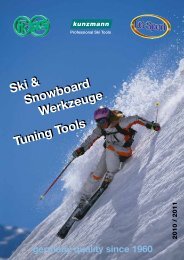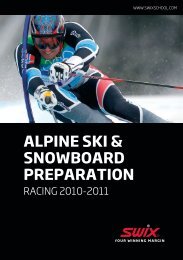NORDIC SKI PREPARATION
NORDIC SKI PREPARATION
NORDIC SKI PREPARATION
Create successful ePaper yourself
Turn your PDF publications into a flip-book with our unique Google optimized e-Paper software.
FACTORS INFLUENCING WAXING<br />
The purpose of waxing is either to create friction,<br />
or grip, in the case of kick wax, or to reduce it as<br />
with glide wax. The intention with the waxing<br />
process is to make the ski base as compatible as<br />
possible with the features of the snow surface.<br />
However, the snow conditions change with time<br />
and temperature. Even when temperatures<br />
remain below freezing, time (hours and days) will<br />
progressively deform sharp, classic snow crystals<br />
into more rounded forms. We call this transformed<br />
snow. The higher the temperature, the faster the<br />
transformation will proceed.<br />
Water also plays a significant role. Water<br />
molecules surround snow crystals as thin water<br />
films even when temperatures are below the<br />
freezing point. Above freezing, water plays a<br />
greater role as free water mixes with the snow<br />
pack. The distribution of water and ice will influence<br />
friction and abrasiveness. Therefore<br />
modern Swix waxes take into consideration many<br />
factors in their formulation and composition. The<br />
result is different waxes for different conditions.<br />
In this chapter Swix will guide you through the<br />
main features of snow and friction to make the<br />
choice of the proper ski wax easier.<br />
Temperature<br />
Taking a reading of the air temperature in the<br />
shade is the first basic starting point for wax<br />
selection.<br />
This should be done at several points along<br />
the course. Snow temperature at the surface can<br />
also be helpful. But remember that once the temperature<br />
reaches the freezing point (0°C or 32°F),<br />
snow will remain at that temperature regardless<br />
of rising air temperature. At this point it is best<br />
to use air temperatures and focus on the proper<br />
steps for dealing with the increased water content<br />
of the snow.<br />
Humidity<br />
Humidity is important, but more as a local climate<br />
trend rather than a need to measure every percentile.<br />
It is important to know if the competition<br />
is taking place in a dry climate, meaning average<br />
humidity below 50%; a normal climate of 50% to<br />
80%, or a high humidity climate 80% to 100%.<br />
Beyond this, of course, is adjusting to the situation<br />
of falling precipitation.<br />
Snow Granulation<br />
The appearance of the snow crystal and consequent<br />
snow surface is important for wax selection.<br />
Falling, or very fresh new fallen snow is<br />
the most critical situation for waxing. The sharp<br />
crystals require a wax that will resist snow crystal<br />
penetration, but at warmer temperatures must<br />
also have the ability to repel water. It is in this<br />
special, critical waxing situation that Cera F excels.<br />
Man-made snow is today common racing<br />
situations. Freshly made snow at cold temperature<br />
definitely require the addition of synthetic<br />
paraffin such as with CH4, LF4, HF4, HF4BW and<br />
CH6, LF6, HF6 and HF6BW. After man-made snow<br />
has “settled” for some days and the surrounding<br />
atmosphere has affected the snow surface,<br />
the gliding characteristics of the snow improve<br />
and normal waxing considerations return.<br />
At rising air temperatures above 0°C (32°F)<br />
the snow temperature still remains at 0°C (32°F).<br />
The water surrounding the snow crystals increases<br />
until the snow pack becomes saturated with<br />
water. Waxes that are highly water repellent and<br />
coarse base structures are needed.<br />
Snow friction<br />
The friction on ice and snow is a mixed friction.<br />
It means that it is neither a true dry friction nor<br />
a true fluid friction. The contact is partly dry,<br />
partly wet. At very low temperatures the frictional<br />
mechanisms gradually might be described by laws<br />
governing dry friction.<br />
At intermediate freezing temperatures,<br />
around -4°C to -10°C (25°F to 14°F), the water<br />
film between the frictional partners has the optimal<br />
thickness to create low kinetic friction.<br />
Approaching the freezing point, the water film<br />
increases in thickness, and when conditions for<br />
melting is present, free water enters the system.<br />
The contact area between ski and snow<br />
increases and the friction will increase.<br />
Suction gradually builds up as the amount<br />
of water increases.<br />
Swix Snow Classification<br />
System<br />
Swix has introduced a simple classification<br />
system for snow identification. The symbols<br />
are created to help skiers find the best wax<br />
for actual conditions.<br />
Group 1.<br />
Falling and new fallen snow characterized by<br />
relatively sharp crystals, demanding relatively<br />
hard ski wax.<br />
Group 2.<br />
An intermediate transformation stage, characterized<br />
by grains no longer possible to identify as the<br />
original snow-crystal shape; often called “finegrained”<br />
snow in ski-wax terminology.<br />
Group 3.<br />
The final stage of transformation. Uniform, rounded,<br />
bonded grains characterize the snow surface.<br />
Also called “old” snow.<br />
Group 4.<br />
Wet snow. If snow-grains belonging to group 1,<br />
2 or 3 are exposed to warm weather, the result<br />
is wet snow.<br />
Group 5.<br />
Frozen or refrozen. When wet snow freezes it<br />
is identified as group 5, characterized by large<br />
grains with frozen melt water in between.<br />
The snow surface is hard and icy, normally requiring<br />
a klister as kick wax.<br />
1. NEW FALLEN SNOW<br />
Below freezing<br />
3. OLD / GRAINED /<br />
TRANSFORMED SNOW<br />
Below freezing<br />
2. FINE GRAINED SNOW<br />
Below freezing<br />
4. WET CORN SNOW<br />
Above freezing<br />
5. FROZEN CORN (Old) SNOW (Melted/Frozen)<br />
Below freezing<br />
2 3





